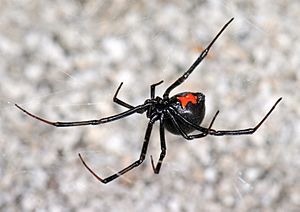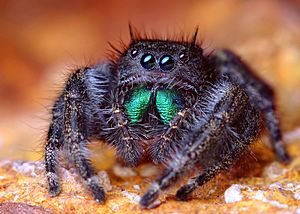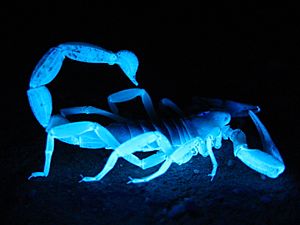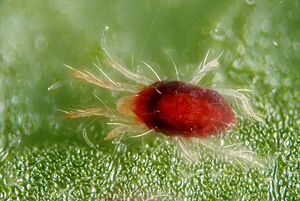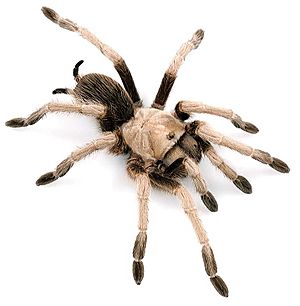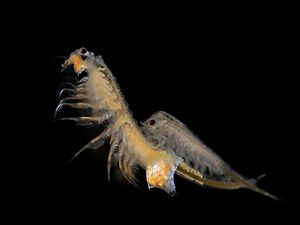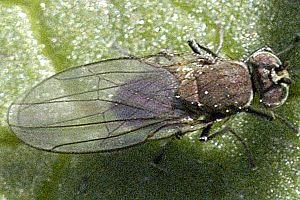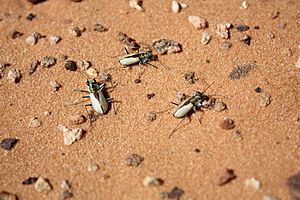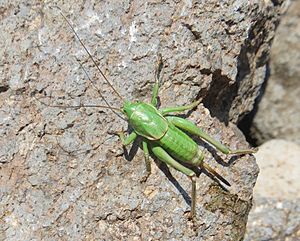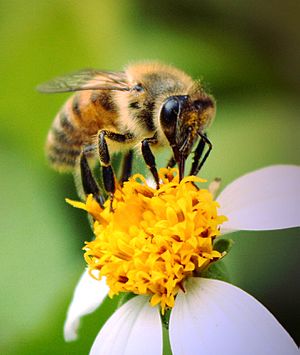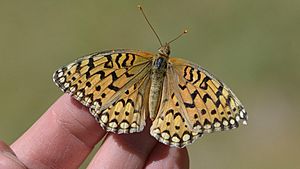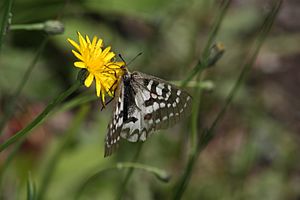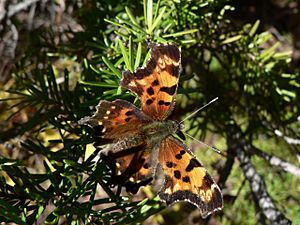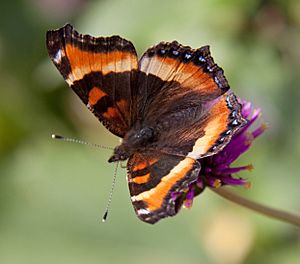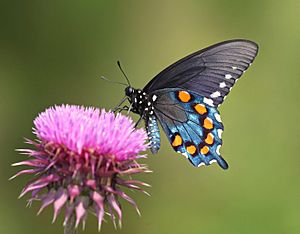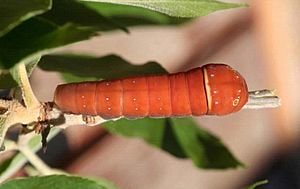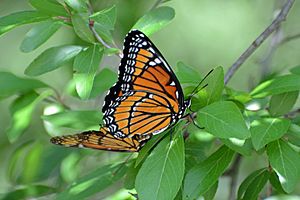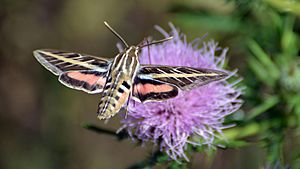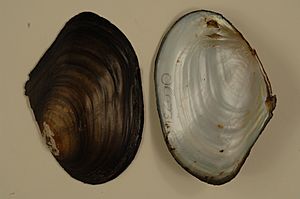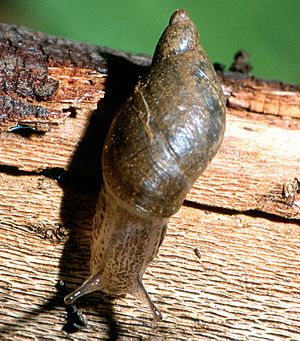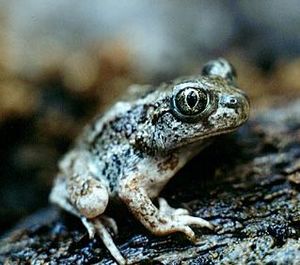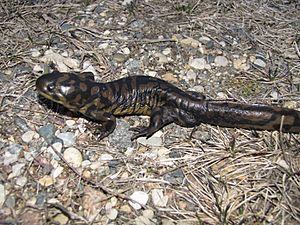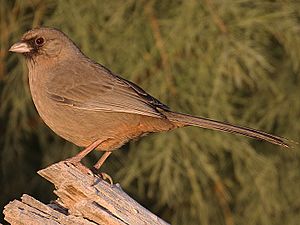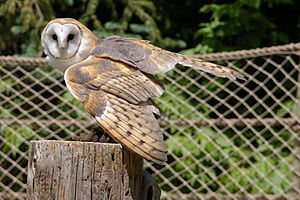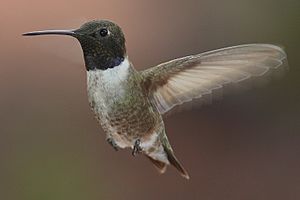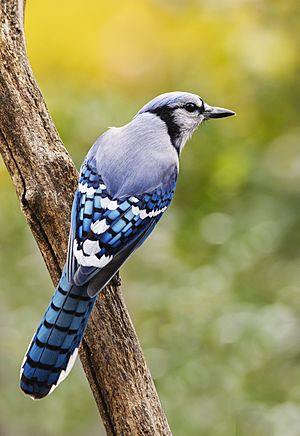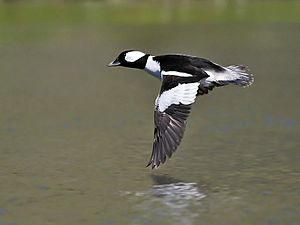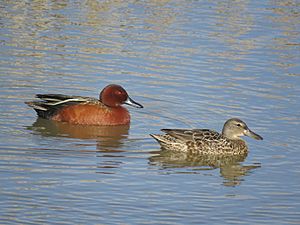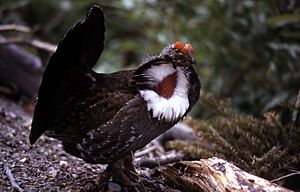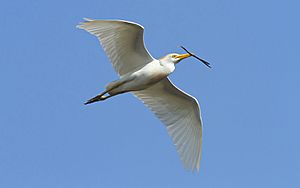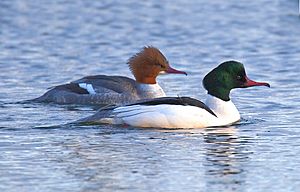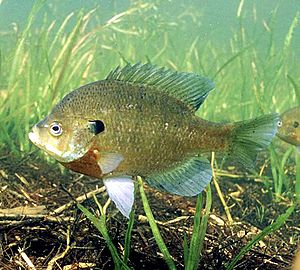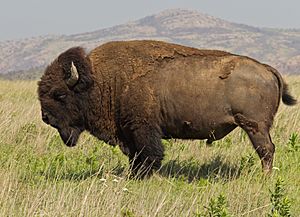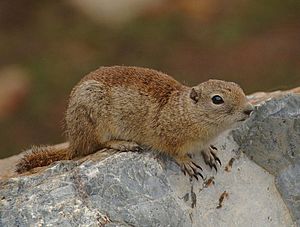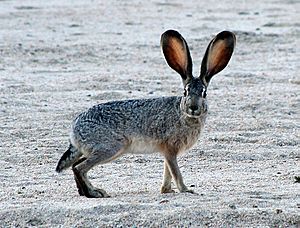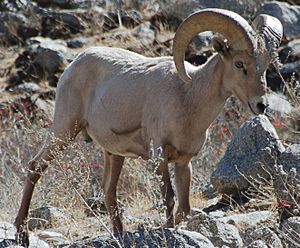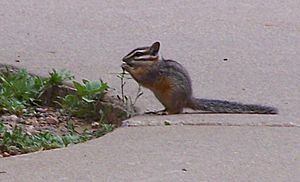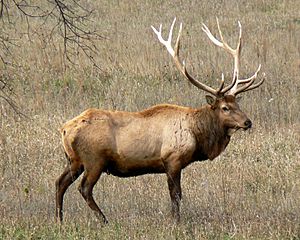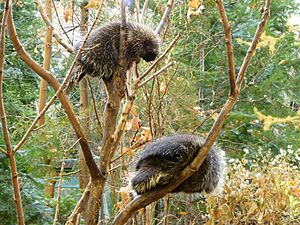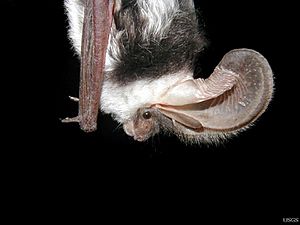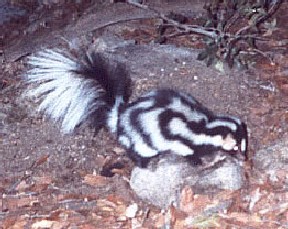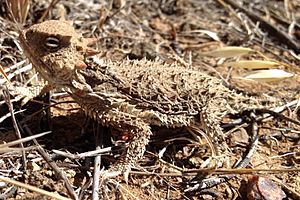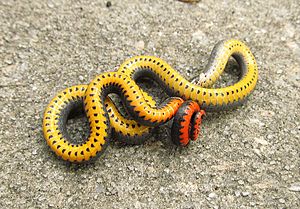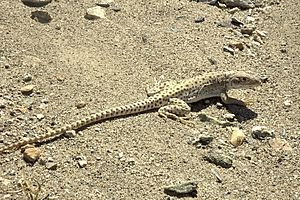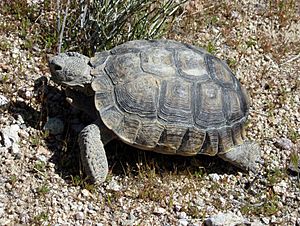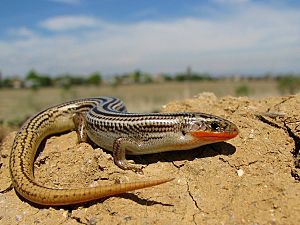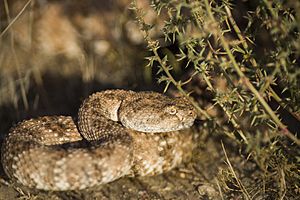List of fauna of Utah facts for kids
Utah is a state in the western United States. It's known for its amazing landscapes, from deserts to mountains. These different places are home to a huge variety of animals! This article will introduce you to some of the cool creatures that live in Utah, from tiny insects to large mammals.
Creepy Crawlies and More: Invertebrates
Invertebrates are animals without a backbone. This group includes insects, spiders, crabs, and snails. Utah has many different kinds of invertebrates, each playing an important role in the environment.
Spiders and Scorpions: Arachnids
Arachnids are a group of invertebrates that include spiders, scorpions, and mites. They usually have eight legs. Utah is home to many fascinating arachnids.
- Western black widow spider (Latrodectus hesperus): These spiders are known for the red hourglass shape on their belly. They prefer dark, quiet places.
- Bold jumping spider (Phidippus audax): These small, fuzzy spiders are great hunters. They have excellent eyesight and jump on their prey.
- Giant desert hairy scorpion (Hadrurus arizonensis): This is the largest scorpion in North America. It glows under UV light!
- Salt Lake County brown tarantula (Aphonopelma iodius): These large, hairy spiders are often found in the desert areas. They are generally harmless to humans.
- Hobo spider (Tegenaria agrestis): This spider builds funnel-shaped webs.
- Rocky Mountain wood tick (Dermacentor andersoni): Ticks are tiny arachnids that feed on blood. This one is found in wooded areas.
Shells and Swimmers: Crustaceans
Crustaceans are mostly water-dwelling animals with hard outer shells. Think crabs, shrimp, and lobsters.
- Brine shrimp (Artemia franciscana): These tiny shrimp live in very salty water, like the Great Salt Lake. They are a major food source for many birds.
- Louisiana crayfish (Procambarus clarkii): This crayfish is not native to Utah. It is considered an invasive species, meaning it can harm the local environment.
- Pill bug (Armadillidium vulgare): Also called "sow bugs," these small creatures roll into a ball when they feel threatened. They live on land in damp places.
- Signal crayfish (Pacifastacus leniusculus): This native crayfish is found in some Utah waters, including Utah County.
- Water flea (Daphnia lumholtzi): Another invasive species, these tiny crustaceans can outcompete native species for food.
Busy Bugs: Insects
Insects are the largest group of animals on Earth. They have six legs and usually wings. Utah is buzzing with many types of insects.
- Brine fly (Ephydra cinerea Jones): Like brine shrimp, these flies thrive in the super salty waters of the Great Salt Lake.
- Coral Pink Sand Dunes tiger beetle (Cicindela albissima): This rare beetle lives only in the unique pink sand dunes of southern Utah.
- Mormon cricket (Anabrus simplex): These large, flightless crickets are famous for their huge swarms. They can cause a lot of damage to crops.
- Western honey bee (Apis mellifera): These important insects help pollinate plants, which means they help plants make seeds and fruits.
- Brown marmorated stink bug (Halyomorpha halys): This is another invasive species. It can be a pest in homes and gardens.
- Common earwig (Forficula auricularia): Also known as the European earwig, these insects have pincers at the end of their body.
Beautiful Wings: Butterflies and Moths
Utah is home to many colorful butterflies and moths. These insects go through a complete life cycle, from egg to caterpillar to chrysalis (or cocoon) to adult.
- Monarch butterfly (Danaus plexippus): Famous for their long migrations, monarchs are a beloved sight in Utah.
- Two-tailed swallowtail butterfly (Papilio multicaudata): This large, yellow butterfly has two "tails" on each hindwing. Its caterpillars are also very interesting!
- Painted lady butterfly (Vanessa cardui): One of the most widespread butterflies in the world, often seen in Utah.
- Viceroy butterfly (Limenitis archippus): This butterfly looks very similar to the Monarch, which helps protect it from predators.
- White-lined sphinx moth (Hyles lineata): These moths are often mistaken for hummingbirds because they hover over flowers.
Slimy Friends: Mollusks
Mollusks are soft-bodied animals, many of which have shells. In Utah, you'll find snails and mussels.
- California floater (Anodonta californiensis): This is a type of freshwater mussel found in Utah's rivers and lakes.
- Kanab ambersnail (Oxyloma kanabense): This tiny snail is an endangered species. It lives only in a few wet areas near Kanab, Utah.
- New Zealand mud snail (Potamopyrgus antipodarum): This is a very small, invasive snail. It can quickly take over waterways and harm native species.
- Quagga mussel (Dreissena bugensis): Another invasive species, these mussels can clog pipes and damage ecosystems. They have been found in Lake Powell.
Other Invertebrates
- House centipede (Scutigera coleoptrata): These fast-moving creatures have many legs. They are often found in homes and eat other insects.
Backbones and Beyond: Vertebrates
Vertebrates are animals with a backbone. This group includes fish, amphibians, reptiles, birds, and mammals.
Frogs and Salamanders: Amphibians
Amphibians are animals that can live both in water and on land. They usually have moist skin.
- Great Basin spadefoot (Spea intermontana): These toads have a special "spade" on their feet to dig into the ground. They come out during rains.
- Tiger salamander (Ambystoma tigrinum): This is the only native salamander species found in Utah. They are often found near ponds and slow-moving water.
- American bullfrog (Rana catesbeiana): This is a large, non-native frog that can harm native frog populations.
- Relict leopard frog (Rana onca): This frog is endangered and might even be gone from Utah completely. Conservation efforts are trying to protect it.
Feathered Friends: Birds
Utah is a great place for birdwatching, with many different species living here or passing through.
- American robin (Turdus migratorius): A very common bird, often seen in yards and parks.
- Bald eagle (Haliaeetus leucocephalus): The national bird of the United States, bald eagles can be seen in Utah, especially in winter.
- Barn owl (Tyto alba): These owls are known for their heart-shaped faces and silent flight. They often live in barns and old buildings.
- Black-billed magpie (Pica hudsonia): These intelligent birds are easily recognized by their long tails and black and white feathers.
- California condor (Gymnogyps californianus): This is one of the largest and rarest birds in North America. It is an endangered species, and efforts are being made to help it recover in Utah.
- California gull (Larus californicus): Often called "seagulls," these birds are very common around the Great Salt Lake. They are even Utah's state bird!
- Common raven (Corvus corax): These large, black birds are very smart and can be found throughout Utah.
- Dusky grouse (Dendragapus obscurus): These birds live in mountain forests and are known for their camouflaged feathers.
- Hummingbirds (various species like Archilochus alexandri and Selasphorus platycercus): These tiny birds are amazing flyers, known for hovering and drinking nectar from flowers.
Swimming Wonders: Fishes
Utah's lakes and rivers are home to many fish species, both native and introduced.
- Bear Lake sculpin (Cottus extensus): This unique fish is found only in Bear Lake. It's listed as "vulnerable," meaning it needs protection.
- Bonneville cutthroat trout (Oncorhynchus clarkii utah): This native trout is an important fish in Utah's history and ecosystems.
- Bonytail chub (Gila elegans): This fish is critically endangered. It lives in the Colorado River system.
- Bluegill (Lepomis macrochirus): A common fish in many Utah waters, but it was introduced and is not native.
- Colorado pikeminnow (Ptychocheilus lucius): This large, native fish is also vulnerable and lives in the Colorado River.
- June sucker (Chasmistes liorus): This fish is found only in Utah Lake and is an endangered species.
- Utah Lake sculpin (Cottus echinatus): Sadly, this fish is extinct. It was last seen in the 1920s.
Furry Friends: Mammals
Mammals are warm-blooded animals with fur or hair. They feed their young milk. Utah has a wide range of mammals, from tiny mice to large elk.
- American bison (Bison bison): These massive animals once roamed freely across the plains. You can find herds in places like Antelope Island State Park.
- American black bear (Ursus americanus): Black bears live in Utah's forests. They are usually shy and avoid people.
- Bobcat (Lynx rufus): These wild cats are smaller than cougars. They are excellent hunters.
- Cougar (Puma concolor): Also known as mountain lions, cougars are Utah's largest wild cats. They are powerful predators.
- Coyote (Canis latrans): Coyotes are common throughout Utah, from deserts to mountains. They are very adaptable.
- Elk (Cervus canadensis): These large deer are a majestic sight in Utah's mountains. They are also called Wapati.
- Mule deer (Odocoileus hemionus): Mule deer are very common in Utah. They are named for their large, mule-like ears.
- North American porcupine (Erethizon dorsatum): These animals are covered in sharp quills for defense.
- Rocky Mountain bighorn sheep (Ovis canadensis canadensis): These sheep are known for their impressive curved horns. They live in rocky, mountainous areas.
- Spotted bat (Euderma maculatum): This bat has huge ears and a unique black and white spotted fur pattern. It's a rare sight.
- Wolverine (Gulo gulo): Wolverines are powerful, solitary animals. They are very rare in Utah.
- Gray wolf (Canis lupus): While there have been sightings, there are no confirmed wolf packs living in Utah. They are very rare visitors.
Scaly Creatures: Reptiles
Reptiles are cold-blooded animals, meaning their body temperature depends on their surroundings. Utah has many snakes and lizards.
- Desert horned lizard (Phrynosoma platyrhinos): Often called "horny toads," these lizards have spiky bodies and can squirt blood from their eyes as a defense!
- Desert tortoise (Gopherus agassizii): These long-lived tortoises live in the desert. They are a protected species.
- Gila monster (Heloderma suspectum): This is one of only two venomous lizards in the world. It has a bright, beaded skin pattern.
- Gopher snake (Pituophis catenifer): These non-venomous snakes are often mistaken for rattlesnakes because they can shake their tails.
- Great Basin rattlesnake (Crotalus oreganus lutosus): This is a common venomous snake in Utah. They use their rattle to warn off threats.
- Long-nosed leopard lizard (Gambelia wislizenii): These fast lizards are good hunters, known for their spotted patterns.
- Ring-necked snake (Diadophis punctatus): These small, harmless snakes have a distinctive yellow or orange ring around their neck.
- Rubber boa (Charina bottae): This snake looks and feels like rubber. It is a non-venomous constrictor.
- Sidewinder (Crotalus cerastes): This rattlesnake moves in a unique "sidewinding" motion across sandy deserts.
- Western fence lizard (Sceloporus occidentalis): These common lizards are often seen basking on rocks and fences.
- Zebra-tailed lizard (Callisaurus draconoides): These lizards are incredibly fast and have a black and white striped tail they wave when they run.


